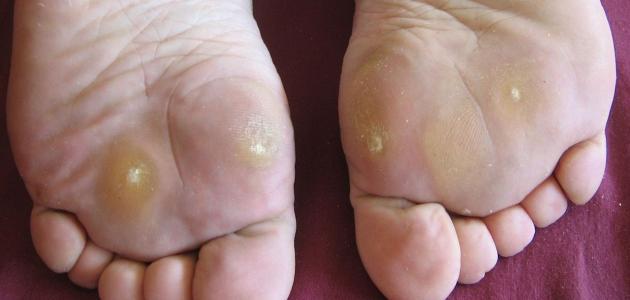Fisheye damage to the foot
Fisheye is a medical condition that some people suffer from when they develop dysfunction in the muscles and tendons in their feet. Generally, this condition is caused by wearing uncomfortable shoes or excessive pressure on the arch of the foot while walking or running.
Here are some common damages that can result from a fisheye on the foot:
- Pain and swelling: You may suffer from severe pain in the affected area of the foot, and this may result in swelling and redness in the affected area.
- Difficulty walking: Patients may have difficulty walking or standing for long periods of time due to pain and swelling.
- Neuroinflammation: In some severe cases, fisheye may cause neuritis, which may worsen pain and affect overall foot function.
- Change in gait: Fisheye may affect the normal walking pattern, due to pain and swelling, leading to adjustments in body balance and loss of the ability to walk properly.
If you are suffering from fisheye on the foot, here are some actions you can take to relieve the symptoms and limit the damage:
- Wear appropriate shoes: Choose shoes that are comfortable and suitable for the foot, and avoid high-heeled shoes or tight shoes that put pressure on the affected area.
- Use of casts and protectors: Specially designed foot casts can be used to reduce pressure on the arch of the foot and relieve pain.
- Taking painkillers: In case of severe pain, painkillers prescribed by the doctor can be used to relieve pain and swelling.
Whatever fisheye damage you are suffering from, it is important that you contact health professionals to get the correct diagnosis and appropriate treatment. Do not hesitate to seek medical help when needed.
Is fish eye on the foot dangerous?
Fisheye on the foot can be annoying and may look unsightly, but in reality it is often not serious. Fisheye forms as a result of infection with the HPV virus and appears as a small, rough growth at the base of the foot, toes, or heel. The severity of fisheye varies depending on the affected area, and can usually be treated with traditional home methods or with a prescription from a doctor. Fish eye is considered a contagious disease, and it may be transmitted from person to person or transmitted through surfaces. It is preferable to consult a doctor to provide appropriate treatment if fish eye appears in the foot.
How do I get rid of fisheye permanently?
If you suffer from fisheye in the foot, do not worry, you can get rid of it permanently by following some appropriate instructions and prevention. Here are some tips that can help you overcome fisheye:
- Using a honey mask: Honey is a natural substance that has antibacterial and antifungal properties. You can apply a cloth soaked in honey to the affected part of the foot, cover it with a clean bandage, and leave it for a few hours. Repeat this treatment daily until the fish eye is gone.
- Using tea tree oil: Tea tree oil is considered antifungal and can be used to get rid of fisheye. Apply a few drops of tea tree oil to the affected part of the foot and massage it gently. Repeat this treatment twice a day until the fish eye disappears.
- Maintain personal hygiene: The foot area must be kept clean and dry on a regular basis. Wash your feet using antibacterial soap and dry them well after showering. It is also recommended to change socks and shoes daily to limit the spread of fungi.
- Avoid sharing in public places: You should avoid sharing in wet and warm places such as galleries, public swimming pools, and public bathrooms. These places may be contaminated with fungi and can increase fisheye transmission.
- Consult a doctor: If the fish eye persists and your condition does not improve after applying these tips, it is preferable to consult a doctor. The doctor may suggest other treatments, such as using antifungal ointments or taking oral medications to eliminate the infection.
Taking care of the health of your feet and following appropriate prevention will help you get rid of fisheye permanently and maintain the health of your feet. Do not hesitate to follow the mentioned tips and consult a doctor if you need additional treatment.
Is fisheye removal painful?
When it comes to fisheye removal, pain is a concern for many people. Will the procedure be painful? This is what we will cover in this text, so that you know what to expect when you undergo fisheye removal.
First, we must mention that the fisheye removal process depends on the size, depth, and location of the injury. In some cases, the procedure can be completely painless, while in other cases, the patient may feel some pain.
Generally, local anesthesia or local anesthesia is used to remove fish eye. This means that the affected area will be numb and you will not feel any pain during the procedure. You may feel some pressure or tingling during the procedure, but this is not considered severe pain.
After the procedure, you may feel some pain and swelling in the affected area. This is normal and can be controlled by taking painkillers prescribed by the doctor. Healing may take a few days or several weeks depending on the size of the wound and your body's reaction.
It is important to know that the level of pain and pain tolerance varies from person to person. So, the pain may be less or more for you than for others. If you have any concerns or concerns about pain, you should speak with your physician for advice specific to your particular condition.
You should know that fisheye removal is a medical procedure and is performed by a qualified medical professional. If you follow your doctor's instructions and commit to rest and proper wound care after the operation, you can recover quickly and heal smoothly without excessive pain.
Why do fish eyes appear in men?
Here is a list explaining the causes of fish eye in men, based on information available online:
- HPV virus: Fisheyes are small, hard bumps of skin that form as a result of infection with the HPV virus (Human Papillomavirus). This virus is transmitted from one person to another through direct contact with infected skin or through minor wounds on the foot. In most cases, fisheye occurs in children due to their weak immune system.
- Dead skin: Fish eye occurs as a result of the presence of dead skin in the toes and its merging with the rough tissue that grows on part of the skin. This creates the hard, thick bumps that fisheyes are famous for.
- Human Papilloma: HPV belongs to the human papilloma virus family. This virus accelerates the growth of keratin, a hard protein found in the top layer of skin. This acceleration of growth leads to the formation of the fish eye.
- Direct contact: Benign HPV may be transmitted by direct contact with infected skin. Therefore, direct contact with a person suffering from fisheye is a major factor in the transmission of the virus and the appearance of plantar warts.
Although fisheye in men can be very annoying and itchy, it can be treated and eliminated with appropriate medical treatments. It is usually recommended to visit a doctor to obtain an accurate diagnosis and advice about appropriate treatment.
Is fish eye cancer?
Fish eye is a common skin condition that may affect the foot. Although it causes pain, fisheye is not cancerous in itself.
Fish eye is a skin condition scientifically called “dermatophytosis”. They usually appear on the feet, but they can also appear on other parts of the body. The fisheye looks like a small ring of thick, rough skin, with a protected nucleus in the middle that resembles a fork, which is surrounded by smoother skin.
Although fisheye can cause pain and itching, it is not dangerous and is often harmless to the health of the person who has it. However, constant friction and friction between rough skin and tight shoes can aggravate the condition and increase pain and irritation.
It is best to work to prevent fisheye by avoiding constant friction and using comfortable, well-fitting shoes. It may also be helpful to use a skin moisturizer and keep your feet clean.
If you suffer from fisheye in the foot, you can contact your doctor for advice and appropriate treatment. The doctor may recommend procedures such as surgically removing the fish eye or using special skin ointments to relieve symptoms and chafing.
Although fisheye is not cancerous, it is best to take good care of your feet and follow preventive measures to maintain healthy skin and prevent any irritations or other skin conditions.
How long does fisheye treatment take?
Unfortunately, fisheye treatment may take some time before it disappears completely. Treatment time depends on several factors, including the size and depth of the fish's eye and the effort you put into caring for it.
In some simple cases, fisheye can disappear on its own within two weeks to three months. However, if the fisheye is large or deep, it may take longer to heal.
There are many home remedies that can be used to relieve fish eye symptoms and speed up the healing process. These treatments can include using antibacterial ointments, applying lubricating bandages, and applying light pressure to the affected area.
If fish eye continues to be irritated and painful for a long time without improvement, it is best to consult a doctor. Doctors can offer more aggressive treatment including using a laser or performing surgery to remove the fish eye.
Whatever the case, it is important to take care of your feet and take preventive measures to avoid fisheye in the future. Make sure to wear appropriate, comfortable shoes and avoid excessive pressure on the foot. A consultation with a podiatrist can also help you identify possible causes of fisheye and guide you on preventing it.
Is fish eye on foot contagious?
Fisheye on the foot is contagious. HPV, which causes fisheye, is an infection and spreads from person to person through direct contact. The virus may be transmitted by sharing personal items or skin-to-skin contact with an infected person. Therefore, it is necessary to take precautions to avoid transmission.
What is the shape of a fish eye in the foot?
Fisheye on the foot is a phenomenon in which a hard and thickened area of skin appears in the form of small bumps. These bumps usually appear on one or both feet, and occur as a result of repeated pressure and friction on the skin. Fisheyes are caused by human papillomavirus, and are also known as plantar warts or warts. Fisheye often grow in areas that take the most pressure, such as the ball of the foot and the heel. White or yellow scars or pimples may appear in the place of the fish eye. The appearance of small yellow pimples or spots on the soles of the feet is considered a sign that the person has a fish eye.



